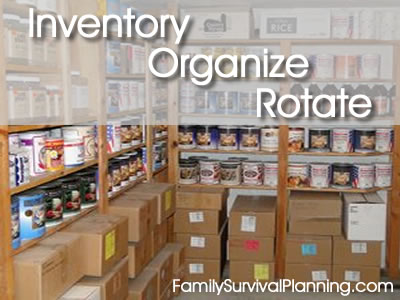Easy Ways to Inventory Food at Home

- HOME
- Food Storage Guidelines
- Survival Supplies Inventory
How to Inventory, Organize, and
Rotate Food Storage Supplies

We all would love our food storage to be organized, easy to rotate, and to know exactly how much inventory we have. I know I dream of a perfectly built storage room with those expensive shelves that just let the oldest cans roll down to the front of the shelf so I know I'm rotating my foods properly.
Yes, I can dream, but short of that perfection, just a little organization can make food storage workable.
We can waste a lot of food, money, and time if we don't know exactly what's in our food storage and where it's located.
So let's start with:
Valley Food Storage has food in-hand and available today for an order of any size. Add some protein to your stock, or beef up your calorie count with a 525 Serving Kit. The options are endless.

Inventory Your Supplies
Grab a piece of paper or a notebook and draw three columns with these headings:
- Product,
- Amount,
- Date Purchased. (Hopefully, you know when you purchased the item.)
If you are inventorying ALL your supplies, those that are not food do not need a purchase date. Go through every single item you have stored.
While you have everything pulled out, use a black permanent marker to write the purchase date on every can or box of food. This is SO important for rotating food products. I keep a marker handy in my kitchen and when I bring home groceries, I write the dates on items that will go into my storage.
Since I'm kind of a planning nut, I have looked high and low for what I consider the perfect preparedness planner where I can keep track of everything - food, water, personal information, bug out bag supplies - all of it.
Organize, Organize, Organize
There are many ways to organize. A couple of examples would be:
- Organize by putting all the canned fruit in one place, the canned vegetables in another, the canned soups in another.
- Organize by storage method - all canned items on one set of shelves, all freeze-dried cans on another.
The method really depends on how your home is set up. I have a basement where I have dedicated one large room to ALL my survival supplies and food. Others may not have a basement or any large space to dedicate just to emergency supplies. If you don't have that kind of storage space, it is even more important to organize and take an inventory that is written down and kept up to date.
Rotating Your Food Storage
As you all know, different foods have varying expiration dates or shelf life. The shelf life also depends on the method used to preserve the food.
- Most freeze-dried foods have a shelf life of 10-30 years.
- Most store-bought canned foods have a shelf life of about 1-3 years. ("Use-by" dates are not necessarily the same as shelf life. They are dates required by law - or lawyers - to avoid liabilities to the store and the manufacturer.)
- Home canned foods have a shelf life about the same as store-bought canned foods; however, it depends on the safety of canning methods used and personal choice about taking risks of eating food older than 1-3 years.
For more detailed information on the shelf life of foods, visit Long Term Food Shelf Life and Food Shelf Life for shorter term and perishable foods.
The point is that you should have a method of rotating your food storage — yes, even the wheat that has a shelf life of 30 years. The sooner you use a product, the more nutritious it will be for your family.
The method you adopt for rotating food can be as simple as writing dates on cans, to scrupulously keeping your inventory sheets up to date.
Acquiring Additional Supplies
If you're really ambitious, you can expand your inventory sheet to include products youneed (what you feel is vital, that you are lacking) and what youplan to acquire (what you plan to do within, say, the next 6 months-year to improve your preparedness).
To meet your own goals, whether it is to acquire three month's worth of food or three year's, this should be an ongoing effort of planning and acquiring food, water, warm clothing/bedding, fuel, and, cash emergency funds.
Organizing Products:
What do you think?
I'd love to hear what you have to say in the comments.
Source: https://www.familysurvivalplanning.com/survival-supplies-inventory.html